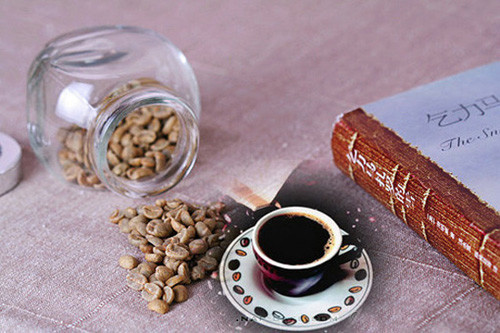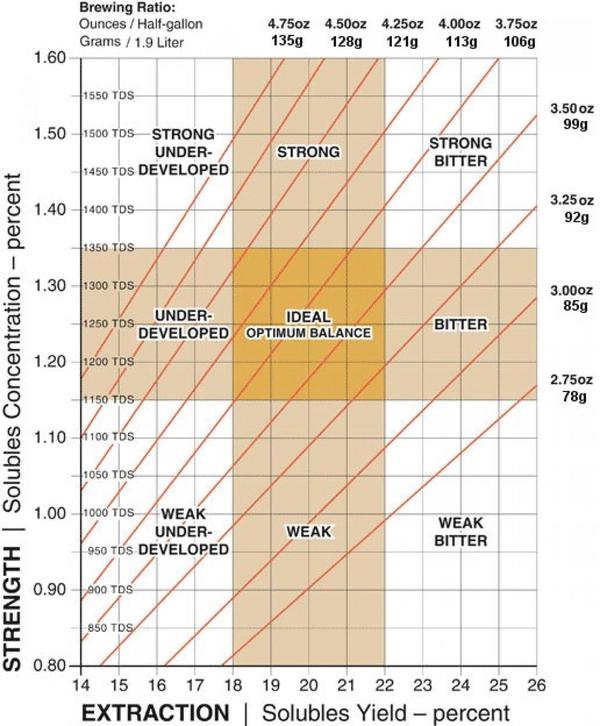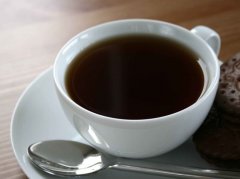The ratio of water to powder refers to the ratio of coffee powder to water injection.

The copyright belongs to the author.
Commercial reprint please contact the author for authorization, non-commercial reprint please indicate the source.
Author: uncle Dewa
Link: http://www.zhihu.com/question/22664244/answer/42860980
Source: Zhihu
First of all, let's talk about a little bit of personal opinion, this parameter is best called powder-water ratio. Because it is generally presented in the way of [1:xx], that is, the ratio of one part of coffee powder to how many parts of water, it is called the ratio of powder to water is more strict.
Let's answer the landlord's question: does the ratio of water to powder refer to the ratio of coffee powder to water injection, or the ratio of coffee powder to production?
First of all, the quantification of the powder-to-water ratio is widely accepted because of the coffee product management table (The Brewing Control Chart) issued by the SCAA (American Fine Coffee Association), which is shown below:

(the picture is quoted from the Internet, and the copyright belongs to the original issuer)
The Brewing Ratio in the upper left corner is what we call the powder-water ratio. Obviously, it refers to the ratio of coffee powder to the amount of water, which refers to the amount of unboiled water that has not yet been boiled.
Let's take a look at its unit: Grams / 1.9Liter, which is mass: volume, not just mass: mass. Maybe many friends don't have measuring cups at home, but don't worry, we can use [quality of coffee powder: quality of water] to calculate the ratio of water to powder. Briefly explain why friends who don't want to be serious can choose to skip:
If you measure unboiled water. High school physics taught us that the density of water at room temperature is equal to 1 (or about 1). Therefore, at room temperature, the mass of 1 mL raw water can be regarded as equal to 1 g (1 g raw water = 1 mL raw water).
If you measure hot water directly, it is more appropriate to use mass units to measure it. Because the density of hot water is lower than that of raw water, the mass of hot water with a volume of 1 mL is less than 1 g. Hot water measured in units of mass is equivalent to the same volume of raw water (1 g hot water = 1 mL raw water, too).
For example, suppose you have 10 grams of coffee powder and use the 1:10 ratio of powder to water to brew. If you use a cup to measure 100 mL of hot water, its mass may be only 97 g, which is 3 g (mL) shorter than 100 mL of raw water. As a result, your powder / water ratio becomes 1 mL 9.7. Using an electronic scale to measure 100g of hot water, although its volume may have expanded to 104mL at that time, it will return to 100mL at room temperature, which is exactly the amount we need.
As for the second part of the main question: siphon, hand punch and legal pressure, what is your favorite gouache ratio?
In fact, everyone's tastes are different, and there is no absolute powder-to-water ratio, so the respondent will not impose his personal preferences on everyone.
It can also be seen from the SCAA coffee product management table given above. Different red slashes in the table represent different powder-to-water ratios, and even in the middle of the small golden matrix region, there are five different red lines passing through.
For you, by adjusting the powder-to-water ratio that best suits your taste, is the best powder-to-water ratio.
Important Notice :
前街咖啡 FrontStreet Coffee has moved to new addredd:
FrontStreet Coffee Address: 315,Donghua East Road,GuangZhou
Tel:020 38364473
- Prev

Perfect ratio of coffee powder to water how to make a perfect cup of coffee
The ratio of coffee powder to water is very important. Here's a look at how to make the perfect cup of coffee. The table shows in detail the coffee powder / water needed to make different cups of coffee. The above picture shows the standard brewing ratio comparison table, which is suitable for most ordinary coffee lovers. You only need to determine the number of cups of coffee and you can directly calculate the amount of coffee powder / water needed. The cartographer at the same time
- Next

Introduction to Coffee knowledge single Coffee extraction equipment
Generally, you can drink coffee to a single product without sugar and milk, which is a high-level veteran. Individual coffee is also known as vegetarian coffee, or Zhai coffee, which shows that ordinary Chinese still have a great misunderstanding about this kind of coffee! After all, in the eyes of most ordinary people, coffee is synonymous with bitterness! No bitter, no coffee! Most of the people who really like individual coffee have drunk the really good ones.
Related
- Detailed explanation of Jadeite planting Land in Panamanian Jadeite Manor introduction to the grading system of Jadeite competitive bidding, Red bid, Green bid and Rose Summer
- Story of Coffee planting in Brenka region of Costa Rica Stonehenge Manor anaerobic heavy honey treatment of flavor mouth
- What's on the barrel of Blue Mountain Coffee beans?
- Can American coffee also pull flowers? How to use hot American style to pull out a good-looking pattern?
- Can you make a cold extract with coffee beans? What is the right proportion for cold-extracted coffee formula?
- Indonesian PWN Gold Mandrine Coffee Origin Features Flavor How to Chong? Mandolin coffee is American.
- A brief introduction to the flavor characteristics of Brazilian yellow bourbon coffee beans
- What is the effect of different water quality on the flavor of cold-extracted coffee? What kind of water is best for brewing coffee?
- Why do you think of Rose Summer whenever you mention Panamanian coffee?
- Introduction to the characteristics of authentic blue mountain coffee bean producing areas? What is the CIB Coffee Authority in Jamaica?

